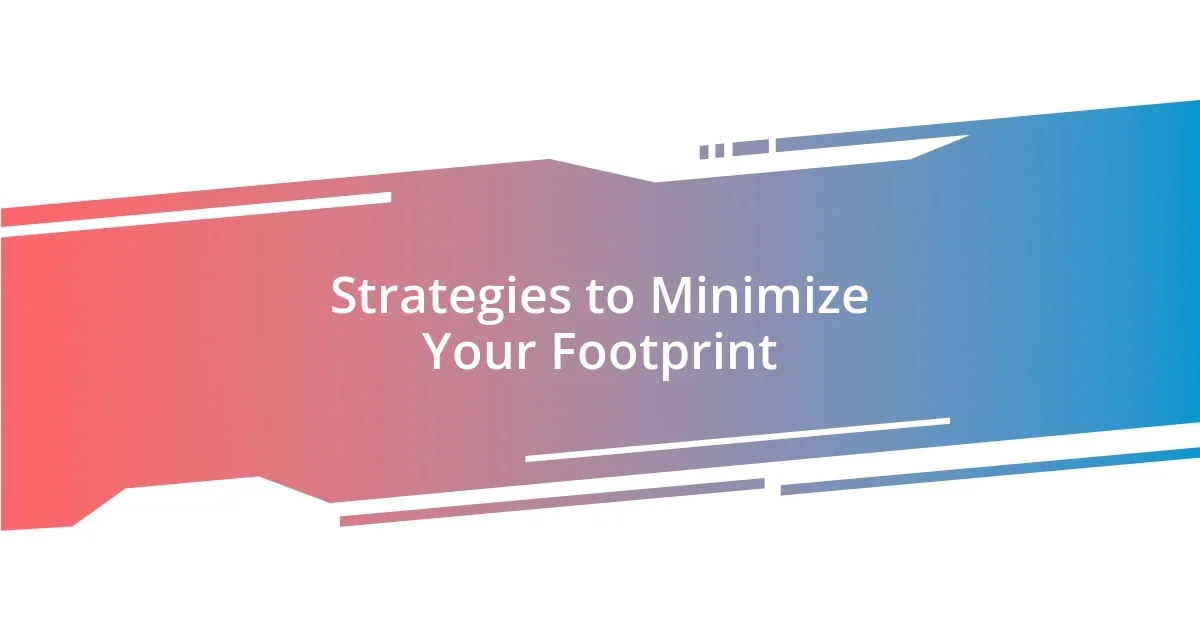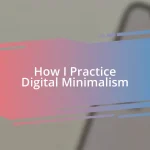Key takeaways:
- Realizing the impact of one’s digital footprint is crucial for managing online reputation, as past posts can affect future opportunities and relationships.
- Regularly assessing privacy settings on social media platforms is essential to ensure personal information remains secure and to avoid unwanted exposure.
- Educating friends and family about the implications of their online presence fosters awareness and encourages responsible sharing of personal information.

Understanding Digital Footprint Importance
Managing my digital footprint has become essential because it shapes how others perceive me online. I remember the moment I realized this—after learning that a potential employer found my old social media posts from college. That was an eye-opener! It made me think, how much do we really control our online image?
When I dig deeper into what it means to have a digital footprint, I can’t help but feel a twinge of vulnerability. My interactions, likes, and shares tell a story about who I am. It’s wild to think how a single post can linger online and affect my relationships, job prospects, and even personal peace. Have you ever Googled yourself? It can be a bit shocking to see the collection of things you’ve put out there—or what others have posted about you.
The emotional weight of managing a digital footprint can’t be underestimated. It’s my reputation and legacy at stake, all hidden behind the screens we scroll through daily. Knowing that anyone, from friends to strangers, can judge me based on this online presence gives me motivation to curate my digital self mindfully. I often ask myself, what narrative do I want to tell, and how can I make sure it reflects my true self?

Identifying Your Online Presence
To truly understand my online presence, I’ve learned that it’s crucial to take a step back and assess what’s out there. Recently, I decided to search my name on various platforms, and the results were somewhat surprising. Old forum posts and comments I’d completely forgotten about resurfaced, reminding me that my online identity is woven together through these seemingly small threads.
Here’s a checklist that helped me identify the components of my online presence:
- Search Engine Results: I start by Googling my name to see what pops up.
- Social Media Profiles: I review each platform—Facebook, Twitter, Instagram—to gauge what others can see.
- Professional Networks: I check LinkedIn for any outdated information or posts that don’t align with my current professional image.
- Comments and Forums: I revisit any threads or discussions I’ve participated in; they contribute to my digital narrative.
- Content Creation: I evaluate any blogs or articles I’ve written to ensure they reflect my values and expertise today.
These steps have not only helped me recognize the content associated with my name but also instilled a sense of accountability. It’s a reminder that every interaction, even those hidden in the depths of the internet, adds to the story I am telling the world.

Assessing Privacy Settings on Platforms
When it comes to privacy settings on various platforms, I’ve found it essential to regularly review them. I once neglected my Facebook privacy settings and was shocked to discover that some of my posts were public. This oversight made me question who had access to my personal thoughts and memories. It’s an unsettling feeling to realize that strangers can view what I thought was private, so I now make it a point to customize my settings every few months.
I’ve also noticed that every platform has its own unique privacy controls. For instance, Instagram offers options to make my account private, ensuring only approved followers can see my content. On the other hand, Twitter provides a separate setting for protecting my tweets. This differentiation can be overwhelming! That’s why I keep a simplified comparison chart handy; it helps me visualize my options across the platforms I use most.
To give you a clearer perspective, I’ve created a simple table that highlights key privacy settings for three popular platforms. I highly recommend checking out the specific settings on your own accounts.
| Platform | Privacy Setting Options |
|---|---|
| Post visibility, friend requests, profile visibility | |
| Account privacy, story sharing, activity status | |
| Tweet protection, direct message settings, discoverability |

Monitoring Your Digital Footprint Regularly
Monitoring my digital footprint is something I now prioritize regularly. Every few months, I dedicate some time to search for my name again. It’s like a check-up for my online identity; I want to spot any new content that may have slipped under my radar. I remember once discovering an old blog post I had written in college, and while I was proud of my youthful enthusiasm, I felt a pang of embarrassment. It made me realize that even those seemingly insignificant bits can impact how people perceive me today.
Alongside searching for my name, I also keep an eye on my social media interactions. A friend of mine once tagged me in a photo that was far from flattering; it stirred up mixed feelings about my online image. This incident reminded me that I not only need to control my own posts but also be mindful of how others represent me. I now regularly scroll through tags and mentions to ensure that everything aligns with how I want to present myself to the world.
Moreover, I take advantage of tools and alerts to stay on top of my digital footprint. Services like Google Alerts notify me whenever my name appears online. The first time I set it up, I felt a bit uneasy—will I really have to see everything? But ultimately, it gives me peace of mind. This proactive approach allows me to monitor my online presence without spending hours manually searching. It’s empowering! Have you ever thought about how often you really check your digital footprint? Regular monitoring truly makes a world of difference in maintaining control over your online narrative.

Strategies to Minimize Your Footprint
One effective strategy I’ve embraced to minimize my digital footprint is to reduce my online presence by decluttering my accounts. A while back, I went through my Facebook friends list and realized I had connections with people I hadn’t spoken to in years, if ever! So, I made the decision to unfriend or restrict access to my profile for those individuals. It was surprisingly freeing to clean up my social network. Have you ever considered how many of your connections are just occupying space?
I’ve also taken to using incognito mode when browsing the web. Initially, I was skeptical about the benefits. But once I learned that it prevents my search history from being saved, it felt liberating! Just recently, I purchased a gift online using incognito mode, which made me feel more secure that my browsing habits wouldn’t be tied to my accounts. It’s a simple step, but it really helps in keeping my online activity private. After all, who doesn’t love a little privacy while shopping?
Lastly, I’ve been more intentional about what I share on social media and online forums. For example, I once posted a photo of my vacation that unknowingly revealed my home address. A close friend called me out on it, reminding me that such oversharing can be risky. That moment led me to create a mental checklist: before I post anything, I ask myself whether it adds value to my network or if it could potentially jeopardize my privacy. It’s a thought-provoking practice that encourages me to be more mindful. Have you ever thought about the impact of what you share? It’s made a big difference for me in managing my digital footprint.

Educating Others About Digital Footprint
Educating others about their digital footprint has become an essential part of my conversations with friends and family. I often share my journey toward understanding the implications of my online presence, illustrating how even a casual post can resonate long after it’s shared. I vividly remember explaining to my younger sibling the potential risks of sharing personal details on social media. It struck me how easily they could overlook the permanence of the internet, which opened up a vital dialogue.
One instance that really hit home was during a family gathering. I noticed my cousin had shared a seemingly harmless photo—until she mentioned the location tag. At that moment, I felt compelled to dive deeper into a discussion about privacy settings and the importance of awareness. I asked her if she realized that even innocent posts could attract unwanted attention. That conversation became a springboard for educating not just her, but others around us about the need to think critically before hitting “post”.
By emphasizing the importance of setting personal boundaries online, I feel like I’m empowering others to take charge of their digital identities. I’ve encouraged friends to use various tools, like privacy settings on platforms they use. Just the other day, I had a friend express relief after updating their settings, saying, “I never knew I could control who sees my posts!” It was gratifying to witness their realization. This process of sharing knowledge feels incredibly fulfilling because I know firsthand how awareness can lead to significant changes in how we navigate our online lives.















